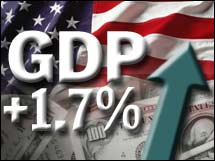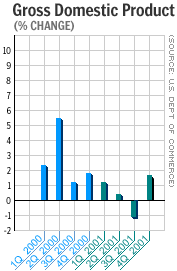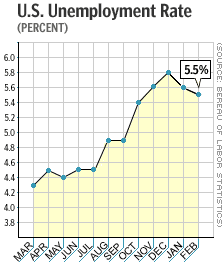
NEW YORK (CNN/Money) -
The United States got several reports about its economic health Thursday, showing rising jobless claims last week, stronger than expected economic growth in the fourth quarter, and resilient consumer confidence in March.
While the individual marks were surprising, the broad picture they painted -- of an economy rebounding from its first recession in a decade, but waiting for job growth to catch up -- was not.
The Labor Department said initial claims for unemployment benefits rose to 394,000 last week from a revised 376,000 the prior week. Economists surveyed by Briefing.com expected 373,000 new claims.
"A lot of American businesses are still fighting the last recession as opposed to gearing up for the next expansion," Putnam Investments economist David Kelly told CNNfn's Before Hours program. "That process could take a few months, so we could still see some ugly numbers from the labor market for another month or two."
Separately, the closely watched University of Michigan consumer sentiment index was revised upward to 95.7 in March -- its highest level since December 2000 -- from an initial reading of 95.0, according to a Reuters report. Economists surveyed by Briefing.com expected the index to stay at 95.0 after a reading of 90.7 in February.

And gross domestic product (GDP), the broadest measure of economic strength, grew a revised annual rate of 1.7 percent in the fourth quarter after shrinking 1.3 percent in the third quarter, the Commerce Department said in its final reading of fourth-quarter GDP. Its previous estimate of fourth-quarter growth was 1.4 percent, and economists surveyed by Briefing.com expected that to be unchanged.
Stocks opened higher on Wall Street, though they gave up much of their gains in the afternoon, and Treasury bond prices fell.
Consumer spending, which made up $6.5 trillion of the total $9.3 trillion GDP, jumped 6.1 percent in the fourth quarter after rising just 1 percent in the third. That rebound helped the economy avoid two straight quarters of shrinking GDP, the common definition of a recession.
"The American consumer really went spending in the fourth quarter in an extraordinary way, and what we're seeing here is confirmation of that trend," Kelly said.
Nevertheless, the National Bureau of Economic Research said the economy sank into recession in March 2001. To keep consumers spending and set the stage for a recovery, the Federal Reserve cut its target for short-term interest rates 11 times in 2001. At its first two meetings in 2002, it decided to leave rates alone, and Fed Chairman Alan Greenspan has said the recession is over.
But it could be some time before economic growth translates into new jobs -- unemployment is a lagging indicator and usually rises even as the economy recovers. In its report Thursday, the Labor Department said the four-week moving average of new jobless claims, which smoothes out fluctuations in the weekly data, rose to 383,500 last week -- the highest level in eight weeks -- from a revised 380,250 the prior week.
And continued claims, the number of people who have been out of work for a week or more, rose to 3.53 million in the week ended Mar. 16, the latest data available, from a revised 3.44 million in the prior week.
"We've seen regular steady declines week in and week out [in the four-week moving average], with the exception of this week. This probably speaks of softness in labor market that continues as a result of the recession," said Jeffrey Wenger, economist at the Economic Policy Institute. "We're sort of muddling towards a tepid recovery."

Still, weekly jobless claims have been below the benchmark 400,000 level for eight straight weeks, the longest such streak since April 2001. The last time weekly claims were below 300,000 was in the week ended Sept. 23, 2000, which saw 291,000 new claims.
And Wenger pointed to another possibly hopeful sign -- an increase in the number of temporary services workers, according to the Labor Department's February unemployment report.
"Firms hire those workers back first, as an easy way to test the market. If it looks like things are robust, then they can hire the temps as permanent workers," Wenger said.
Despite the weakness in the labor market, consumers are still confident about the economy's prospects. The Michigan sentiment report, which is available only to paying subscribers, came two days after another closely watched barometer of consumer feeling, the Conference Board's consumer confidence index, showed surprising strength in March.
The current conditions index, which measures consumers' attitudes about their present financial situation, rose to 100.4 from 87.2 in February, Reuters said. But the expectations index, which measures attitudes about the coming year, fell to 92.7 from 96.2, according to the report.
Businesses to shape recovery
Since consumers never really stopped spending, there's little pent-up consumer demand and thus little chance of a burst of new consumer spending to help make the recovery robust. Much of the strength of the recovery, then, depends on business spending. A slowdown of capital expenditures led to the latest recession, and Greenspan and other economists think business spending will define the shape and strength of the recovery.
But spending will have to wait for corporate profits to recover. Corporate after-tax profits fell by $50.4 billion in the quarter, the biggest such loss since the first quarter of 1998, after falling $34.7 billion in the third. Profits fell 15.9 percent in the year, making it the first negative year since 1982, when profits fell 17.1 percent.
| |
 Related links
Related links
| |
| | |
| | |
|
Business spending on buildings and equipment made up just $1.2 trillion of fourth-quarter GDP, but it fell 13.8 percent in the quarter after falling 8.5 percent in the third. Businesses cut inventories, which had swelled up in the wake of the spending bubble of the late 1990s, by a record $119.3 billion in the quarter, after cutting $61.9 billion in the third.
The inventory reduction took 2.2 percentage points from GDP in the quarter, but set the stage for a return to production and growth in the first quarter. As a result, many economists think the economy will grow in the first quarter by at least 4 percent, the best performance for GDP since the second quarter of 2000.
The end of the inventory reduction process led to the end of a 19-month recession in the manufacturing sector. As further evidence of that recovery, the Chicago Purchasing Managers Index, which measures manufacturing activity in the Chicago area, rose to 55.7 in March from 53.1 in February. Economists surveyed by Briefing.com expected Chicago PMI of just 54.0. An index reading below 50 signals a contracting manufacturing economy, while a reading above 50 suggests expansion.

|

